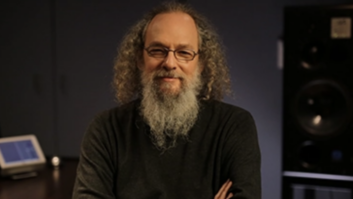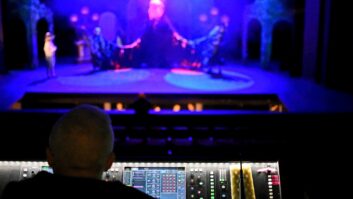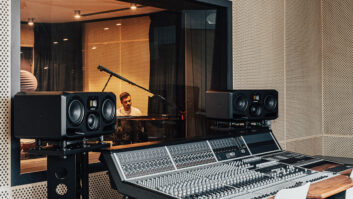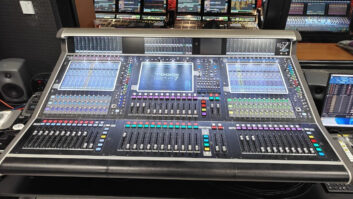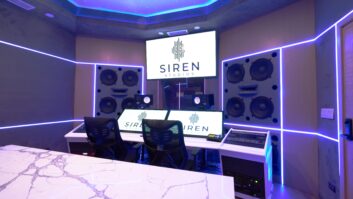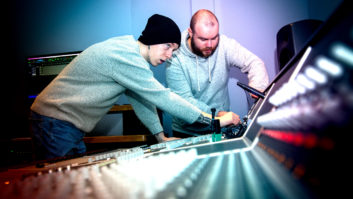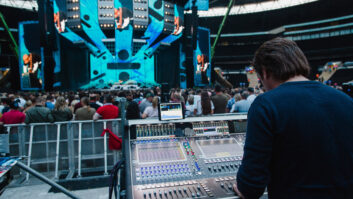The process of big-brand digital audio mixers squeezing into smaller gaps continues as installation markets become ever-more refined. Phil Ward looks through the magnifying glass.
Once again the 2009 PLASA show produced a wave of smaller digital mixing desks, each testing the price-performance ratio to the limit. DiGiCo’s SD8-24 set the pace, offering an even smaller footprint than the SD8 while retaining the DSP whack of Super FPGA and Stealth Digital Processing – quickly followed since the show by the EX-007.
Soundcraft followed suit with the Si1, which joined the Si2 and Si3 in a series of compact reinventions of the successful large-format Vi Series. Roland stepped up with the eminently dovetail-able M-380, and Yamaha continued its characteristically practical evolution of designs with Version 2 of the M7CL – the first version of which was arguably the primary co-ordinate of this arc, with precedents 18 years back into the Yamaha portfolio.
It’s been a clear trajectory. In the past year Innovason has presented the Eclipse, a versatile console with a flexible range of applications. Elsewhere Digidesign concocted the SC48 from the Venue, and Allen & Heath fixed the iLive-T to a price and a feature set that makes it an entry-level alternative to iLive itself. The PRO6 Live Audio System from Midas also uses technology derived from a bigger brother: the influential XL8, which first offered the sample-synchronised audio performance now found in the PRO6. And one newcomer made its arrival: PreSonus, demonstrating extreme economies of scale with the all-encompassing StudioLive.
Localisation
As an expander module for the SD7, the EX-007 quite literally takes DiGiCo’s high-end technology into new corners, providing remote access to the main engine up to 100m away. The footprint is smaller, too, with the obvious advantages to venue ergonomics and economics.
“Digital consoles are now more accepted in the live environment and engineers have got used to assignment and layering,” comments DiGiCo MD James Gordon. “This makes it possible to control a high number of channels with reduced fader count. Space has always been an issue with theatre productions and corporate sound, so being able to offer a large amount of channels and outputs is an attractive solution.
“The SD8 allows a large number of stereo channels and busses in a compact format, but without reducing the total number available. The SD8-24, at under a metre in width, has an even smaller footprint but still no reduction in either functionality or number of inputs and outputs. At the other end of the scale, we have the larger-format SD7 that, at first glance, may not seem like it would work in a small console situation. However, we’ve recently developed the EX-007 that gives the ability to increase the number of available faders and channels substantially, or can be used as a remote surface when space is limited.
“I think the growing trend for small solutions is due to the expansion of digital consoles into other types of live sound. In the beginning they were only used for large West End shows or major tours. Now, regional companies and local theatres have recognised their benefits.”
Andy Brown is head of digital console strategy at Soundcraft-Studer. He believes that, once into the digital realm, product design contains a kind of self-fulfilling prophecy. “To some extent, the trend for physically smaller mixers is the result of manufacturers’ natural drive to produce lower-priced – and therefore smaller – products,” he says. “This is in the relatively immature lower-end digital console market where it’s still an open battleground with market share up for grabs.
“But more importantly it’s that the digital technology itself unlocks a whole range of advantages for breaking up the mixer into chunks and being able to distribute these around a venue, giving advantages such as keeping the I/O on stage with short cable runs to microphones and so reducing the footprint at the control position. There are also further advantages linked to the increased integration of digital audio network technology into mixing consoles, which brings benefits of much greater freedom for system designers to create a system tailored to a particular building and application.
“Also, we think engineers are more relaxed now about using smaller surfaces to access multiple channels since the user interface designs have been greatly improved. We think most manufacturers are now entering the next phase of digital development, where having proved they can build reliable products they are now able to start extracting more of the real benefits that the technology offers.
“Modularity is one of the most important of these and there’s a host of benefits for installations that in most cases are derived from client requirements. These include: FOH space-saving and consequent additional revenue from extra seating or audience capacity; freedom of control from several places yet the ability to have overall control from one location if required; more portability in venues such as sporting arenas where control surfaces could be easily moved to different locations; and more space or freedom for co-placement or substitution by incoming production mixers.”
Liquid channels
Roland’s pro-audio arm RSS has recently announced a range of products that aims to exploit this almost liquid nature in which digital audio is seeping into architecture. Once plumbed in, several further benefits quickly become apparent.
“The current trend towards smaller footprint digital audio reflects the way in which the installation market is shifting and digital audio capability is rapidly developing,” believes Martin Thomas, RSS sales & marketing manager at Roland UK. “The cost implications of installing large-format consoles and FX racks – with the associated infrastructure and, sometimes, lost seat revenue – are obvious. With building costs escalating and budgets shrinking, small feature-rich consoles such as the Roland M-380 rackmount live mixer are an obvious choice. From an installer’s point of view the space saving and benefits of sending audio over Cat5e cable are clear. Lower material cost, easier installation and – in the case of Roland Ethernet Audio Communication – intuitive and reliable operation, all save time and effort for installer and client.”
Midas and Klark Teknik brand development manager Richard Ferriday continues the theme: “The trend for ever-more compact mixers is driven by venue logistics, such as the number of seats occupied by the console, and increasingly competitive pricing. Unfortunately, the price pressure also tends to dictate a monolithic, non-modular design, which is then more likely to be subject to catastrophic failure than a modular type of system.
“When considering different options, the customer should remember the advantages of modular over non-modular analogue consoles, as the same ‘rules’ apply. The modular approach, although more expensive to manufacture, provides greater flexibility of type, and location, of I/O.”
“Feedback from installers and venues demonstrates that the market is constantly looking to reduce the footprint and improve the flexibility of their digital audio distribution systems,” adds Allen & Heath MD Glenn Rogers. “They want increased distribution distances, reduced cabling, more control options, easy interface with industry standard protocols such as EtherSound and AES/EBU, and a future-proof system that can manage any event.
“The benefit to the install sector is reduced costs and labour, huge space savings, increased distribution distances and a wealth of control options. Allen & Heath’s iLive digital mixing system has a flexible, distributed audio design architecture whereby all of the mixing and processing occurs in the on-stage, compact MixRack. There are several variants of this MixRack following the launch at the beginning of 2009 of the smaller, fixed I/O iLive-T racks – the 4U iDR-32 and 6U iDR-48. Combined with their counterpart iLive-T80 and iLive-T112 Control Surfaces, customers are provided with the ideal capacity for typical PA applications with 40-in/24-out to 64-in/36-out systems.
“Venues in many sectors such as theatres, conference centres, hotels and churches employ non-technical staff, and the preset functionality on digital systems allows them to recall complex operations in a managed sound system at the touch of a button, often integrating with other equipment in the venue such as video and lighting.”
Network role
“The key to this is networking,” asserts Nick Cook, European marketing director at Yamaha Commercial Audio. “The very fact that technology has got to the point where you can distribute good quality audio and control across multiple units means that those units can be as large or as small as fits the bill. The smaller sizes are one development, the modularity is another – one doesn’t automatically lead from the other. And as much as end users have asked for any such developments, the logical progress of the technology in itself has created the possibilities – such that we as manufacturers can go to the market with powerful new suggestions about how to use these systems to fix problems.
“We looked at the success of the PM5D and realised we should be making something at a lower price point and with a different type of interface – one that would appeal not only to the pro users but also to those less experienced, for example, volunteers in the house-of-worship market. So the formula was: modify the UI and squeeze the required I/O into smaller formats. We did this, and because of Yamaha Corporation’s business headroom, if you will, we’ve been able to wait until the right moment to release each of the results of this R&D into a market that wanted them.”
Such markets are identifiable by one key requirement, according to Thomas. “Another trend we’ve seen is towards multi-use venues requiring flexible audio requirements throughout the day,” he says. “Our new S-0808 stage boxes and S-4000M REAC merge unit will bring a new level of flexibility to this kind of install requirement. Key benefits are the ability to merge I/O from multiple REAC units back to our M400 and M-380 live mixers and the S-0808 being powered by Power-over-Ethernet or rechargeable battery.
“Since its introduction in spring 2009, the popularity of the RSS M-48 Personal Monitor/Live mixer has grown rapidly and it’s being used in houses of worship and live installations globally. Apart from its mixing capability, the M-48 reduces backline and ambient sound on stage, in studios and front of house. With increasing concern about ‘safe’ sound levels, the M-48 is a great option for live venue installations – another example of compact digital technology providing previously impossible solutions to the market.”
“Midas uses AES50 – 24 bidirectional audio channels per Cat5 connection,” says Ferriday. “This allows for greater granularity of I/O hardware, making it easier to distribute I/O devices to different areas of the stage – or around the building. Modular design also means that the keystone element of the DSP engine can be located in a temperature-controlled, secure environment, leaving only the control surface exposed to the environmental vagaries of the performance area. By removing the audio processing from the console itself, the user interface can now be designed for optimum efficiency and minimal footprint. In addition, Midas’s concept of input navigation by groups instead of layers means the capacity of the ‘mixer’ is not limited by the size of the control surface.
“It’s beneficial that the processing engine is also of modular design, which can then be designed to provide n+1 redundancy of hardware. This means peace of mind during a show and better commercial viability, as the cost of the system is not burdened with an entire backup engine. Modular systems also have the advantage that they can be easily expanded as venue requirements change.”
Whatever the protocol, networking is the oil for the digital audio engine. Last word to Rogers: “iLive uses standard TCP/IP Ethernet network for control,” he explains, “while Allen & Heath’s proprietary ACE (Audio Control Ethernet) link allows cost-effective, long-distance point-to-point control and audio communication between the iLive-T MixRacks and Control Surfaces over a single Cat5 cable up to 120m in length. So it’s easy: iLive has a wealth of options for remote control and MIDI operation, including the PL Series of remote controllers and the iLive Editor control software – a Java-based program enabling users to manage settings easily in a familiar environment on a laptop or PC network.”
